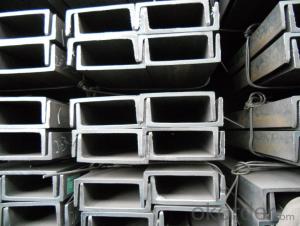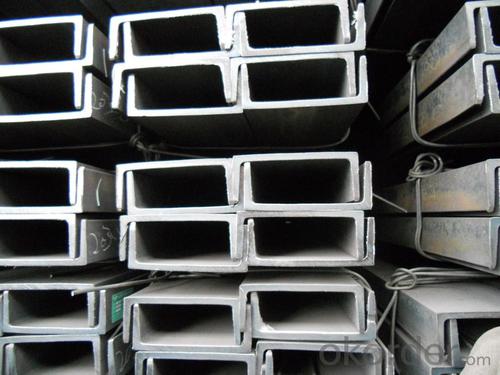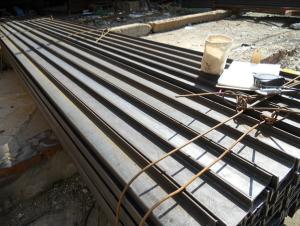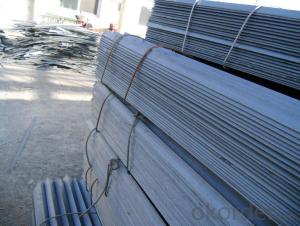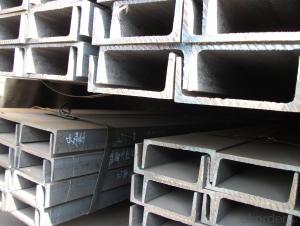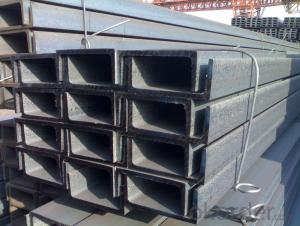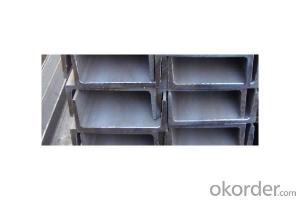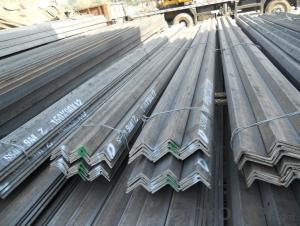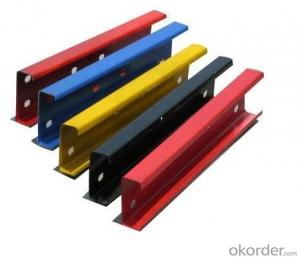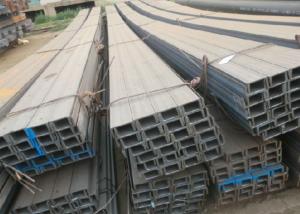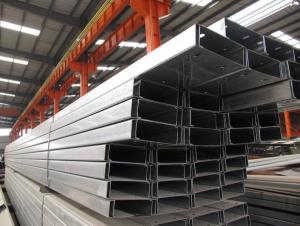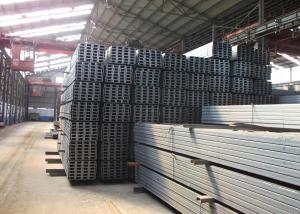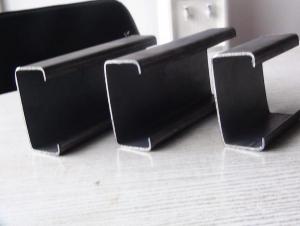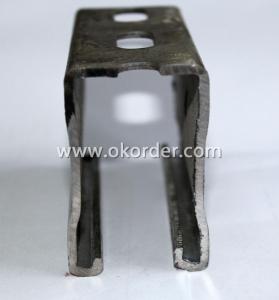MS Hot Rolled Low Carbon Alloy Steel Channel
- Loading Port:
- China main port
- Payment Terms:
- TT OR LC
- Min Order Qty:
- 100 m.t.
- Supply Capability:
- 10000 m.t./month
OKorder Service Pledge
OKorder Financial Service
You Might Also Like
Specification
Product Description:
OKorder is offering MS Hot Rolled Low Carbon Alloy Steel Channel at great prices with worldwide shipping. Our supplier is a world-class manufacturer of steel, with our products utilized the world over. OKorder annually supplies products to African, South American and Asian markets. We provide quotations within 24 hours of receiving an inquiry and guarantee competitive prices.
Product Applications:
MS Hot Rolled Low Carbon Alloy Steel Channel are ideal for structural applications and are widely used in the construction of buildings and bridges, and the manufacturing, petrochemical, and transportation industries.
Product Advantages:
OKorder's MS Hot Rolled Low Carbon Alloy Steel Channel are durable, strong, and wide variety of sizes.
Main Product Features:
· Premium quality
· Prompt delivery & seaworthy packing (30 days after receiving deposit)
· Can be recycled and reused
· Mill test certification
· Professional Service
· Competitive pricing
Product Specifications:
Manufacture: Hot rolled
Grade: Q195 – 235
Certificates: ISO, SGS, BV, CIQ
Length: 6m – 12m, as per customer request
Packaging: Export packing, nude packing, bundled
| JIS STANDARD CHANNEL | ||||||
| SIZE(MM) | h(mm) | b(mm) | s(mm) | t(mm) | kg/m | length |
| 50x25x3x6 | 50 | 25 | 3 | 6 | 2.37 | 6m,12m |
| 75X40x3.8x7 | 75 | 40 | 3.8 | 7 | 5.3 | 6m,12m |
| 75X40x4x7 | 75 | 40 | 4 | 7 | 5.6 | 6m,12m |
| 75X40x4.5x7 | 75 | 40 | 4.5 | 7 | 5.85 | 6m,12m |
| 75X40x5x7 | 75 | 40 | 5 | 7 | 6.92 | 6m,12m |
| 100X50x3.8x6 | 100 | 50 | 3.8 | 6 | 7.3 | 6m,12m |
| 100X50x4.2x6 | 100 | 50 | 4.2 | 6 | 8.03 | 6m,12m |
| 100X50x4.5x7.5 | 100 | 50 | 4.5 | 7.5 | 8.97 | 6m,12m |
| 100X50x5x7.5 | 100 | 50 | 5 | 7.5 | 9.36 | 6m,12m |
| 125X65x5.2x6.8 | 125 | 65 | 5.2 | 6.8 | 11.66 | 6m,12m |
| 125X65x5.3x6.8 | 125 | 65 | 5.3 | 6.8 | 12.17 | 6m,12m |
| 125X65x5.5x8 | 125 | 65 | 5.5 | 8 | 12.91 | 6m,12m |
| 125X65x6x8 | 125 | 65 | 6 | 8 | 13.4 | 6m,12m |
| 150x75x5.5x7.3 | 150 | 75 | 5.5 | 7.3 | 14.66 | 6m,12m |
| 150x75x5.7x10 | 150 | 75 | 5.7 | 10 | 16.71 | 6m,12m |
| 150x75x6x10 | 150 | 75 | 6 | 10 | 17.9 | 6m,12m |
| 150x75x6.5x10 | 150 | 75 | 6.5 | 10 | 18.6 | 6m,12m |
| 200X80x7.5x11 | 200 | 80 | 7.5 | 11 | 24.6 | 6m,12m |
FAQ:
Q1: Why buy Materials & Equipment from OKorder.com?
A1: All products offered byOKorder.com are carefully selected from China's most reliable manufacturing enterprises. Through its ISO certifications, OKorder.com adheres to the highest standards and a commitment to supply chain safety and customer satisfaction.
Q2: How do we guarantee the quality of our products?
A2: We have established an advanced quality management system which conducts strict quality tests at every step, from raw materials to the final product. At the same time, we provide extensive follow-up service assurances as required.
Q3: what is the difference between actual weight and theoretical weight?
A3: All the section steel has two weights: actual weight and theoretical weight. Actual weight is the weighing out when the product delivered from the mill. Theoretical weight is calculated by pieces. The invoice can be based on each of them as your request.
Images:

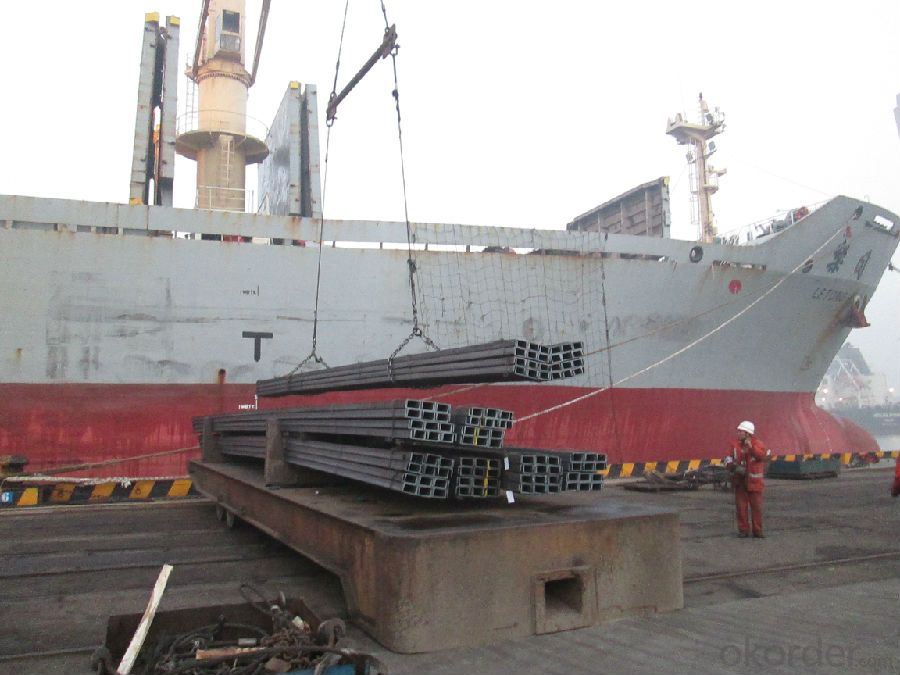
- Q: What are the common material testing procedures for steel channels?
- Common material testing procedures for steel channels include tensile testing, hardness testing, impact testing, and dimensional inspection. Tensile testing involves pulling a sample of the steel channel until it breaks to determine its strength and ductility. Hardness testing measures the resistance of the steel to indentation or scratching, providing an indication of its overall toughness. Impact testing assesses the steel's ability to withstand sudden, high-force impacts. Dimensional inspection ensures that the steel channels meet the required size and shape specifications.
- Q: How are steel channels joined together?
- Steel channels can be joined together using various methods depending on the specific application and requirements. The most common methods include welding, bolting, riveting, and adhesive bonding. Welding is a widely used technique to join steel channels. It involves the fusion of the metal at the joint, creating a strong and durable connection. Different welding processes, such as arc welding or gas welding, can be employed depending on the thickness and composition of the steel channels. Bolting is another popular method for joining steel channels. It involves using bolts, nuts, and washers to secure the channels together. This method allows for easy disassembly and reassembly, making it suitable for applications that require frequent maintenance or adjustments. Riveting is a traditional method that involves driving a metal pin, called a rivet, through holes in the steel channels and then deforming the end to create a permanent connection. Although it requires specialized tools and skills, riveting can provide a strong and reliable joint. Adhesive bonding is a more recent method that utilizes high-strength adhesives to join steel channels. This technique offers several advantages, such as uniform distribution of stress, increased fatigue resistance, and improved aesthetics. However, it requires proper surface preparation and suitable adhesive selection to ensure a reliable bond. In summary, steel channels can be joined together using welding, bolting, riveting, or adhesive bonding, depending on the specific requirements of the application. Each method has its benefits and considerations, and the choice of joining technique should be based on factors such as load-bearing capacity, ease of assembly, maintenance requirements, and cost.
- Q: How do steel channels contribute to the overall safety of a structure during earthquakes?
- Steel channels play a vital role in enhancing the safety of structures during earthquakes due to their ability to provide stability and strength. They are commonly used as components in the structural system to distribute and transfer loads. When an earthquake occurs, these channels act as load-bearing members, effectively absorbing and dispersing the seismic forces to prevent localized damage. The shape and form of steel channels enable them to resist lateral forces and offer resistance against bending and twisting motions caused by seismic waves. By evenly distributing the forces throughout the structure, steel channels help prevent concentrated stress points that could potentially lead to structural failure. Moreover, steel channels are highly durable and resistant to damage, making them ideal for earthquake-prone areas. Their strength-to-weight ratio allows for the construction of lighter yet robust structures. This reduces the overall mass of the building, which in turn decreases the inertia forces generated during an earthquake and minimizes the likelihood of structural collapse. Additionally, steel channels can be integrated into seismic design strategies such as moment resisting frames or braced frames. These systems provide additional rigidity and stiffness to the structure, ensuring its ability to withstand the lateral forces exerted by an earthquake. The flexibility of steel channels also allows for the absorption of energy, thus reducing the impact on the overall structure. In conclusion, steel channels contribute significantly to the safety of structures during earthquakes by providing stability, distributing seismic forces, resisting bending and twisting motions, and reducing mass and inertia forces. Their durability, strength, and energy absorption capabilities make them an essential component in earthquake-resistant design strategies.
- Q: The above four should be all types of steel, but what is the relationship between H steel and I-beam, C section steel and channel steel?Is the I-beam included in the H section, or is it all the same?
- First of all, C steel after cold bending of hot coil and high strength, good tenacity, and channel production can save 30% compared to the same intensity of raw materials, is a direct channel by steel companies, the thickness is greater, it is groove shaped cross section.?Second, C steel is usually used for steel structure building wall beam, beam, bracket or other building components, widely used in the activity room, also can be used in machinery manufacturing industry. Channel steel is mainly used in building structures, vehicle manufacturing, and other industrial structures, often with the use of i-beam. Although the two steels are used in building structures, they are used in different ways.
- Q: What are the different applications of steel channels in the automotive industry?
- The automotive industry extensively uses steel channels due to their versatility and advantageous features. Below are several examples of how steel channels are utilized in the automotive industry: 1. Structural Support: Steel channels are commonly employed to provide structural support in automobile frames, chassis, and body panels. They offer robustness and stiffness, enabling them to bear the vehicle's weight and absorb impact forces during collisions. 2. Reinforcement: Critical areas of the vehicle, such as door frames, pillars, and roof rails, are reinforced using steel channels. This enhances the vehicle's structural integrity and safety, particularly in the event of an accident. 3. Suspension Components: Steel channels are utilized in the production of suspension components, including control arms, sway bars, and trailing arms. These components connect the wheels to the chassis, delivering stability, control, and a smooth ride quality. 4. Bumper Reinforcements: Steel channels are integrated into bumper reinforcements to augment impact resistance and safeguard both the vehicle and its occupants during a collision. They effectively distribute and absorb energy, minimizing damage. 5. Exhaust Systems: Steel channels are utilized in exhaust systems to create the necessary pathways for exhaust gases to exit the vehicle. These channels are designed to withstand the heat, vibrations, and corrosion caused by the exhaust gases. 6. Seat Frames: Steel channels are commonly used in constructing seat frames, ensuring strength and durability. They securely hold the seats in place, providing comfort and safety to the occupants. 7. Roll Cages: Steel channels are employed in fabricating roll cages, which are indispensable safety features in racing vehicles. Roll cages protect the driver in the event of a rollover or crash, preventing the roof from collapsing. To summarize, steel channels play an essential role in the automotive industry, contributing to the strength, safety, and performance of vehicles. Their applications span from providing structural support and reinforcement to manufacturing suspension components, bumper reinforcements, exhaust systems, seat frames, and roll cages.
- Q: Can steel channels be used in signage applications?
- Yes, steel channels can be used in signage applications. Steel channels are often used as a structural support for signage panels, providing strength and stability. They are commonly used for outdoor signage such as billboards, highway signs, and store signs. Steel channels can be mounted horizontally or vertically, depending on the design and size of the sign. They are durable and resistant to weather conditions, making them suitable for long-lasting outdoor signage. Additionally, steel channels can be easily customized and fabricated to meet specific signage requirements, such as size, shape, and color. Overall, steel channels are a versatile and reliable choice for signage applications.
- Q: What are the different cross-sectional shapes available for steel channels?
- Steel channels, which are also known as C-channels or U-channels, find extensive use in the construction, manufacturing, and other industries due to their versatility and strength. These channels exhibit a variety of cross-sectional shapes, each offering distinct advantages and applications. The C-shape represents the most commonly encountered cross-sectional shape for steel channels. C-channels possess a straight back and two perpendicular flanges, which combine to create a profile resembling the letter C. This shape delivers exceptional structural support and often finds employment in building frames, support beams, and structural components. An alternative, widely favored cross-sectional shape is the U-shape. U-channels bear a resemblance to C-channels, but they feature a rounded bottom rather than a straight back. This rounded shape enhances strength and frequently serves applications requiring greater load-bearing capacity like bridge supports and trailer frames. Besides the C and U shapes, steel channels can also manifest in other cross-sectional profiles, including Z-shapes and hat channels. Z-shaped channels possess two flanges facing opposite directions, giving them a visual resemblance to the letter Z when viewed from the end. These channels frequently see use in bracing or framing applications necessitating added stiffness. On the other hand, hat channels consist of a flat horizontal top and bottom with two perpendicular sides, resembling the shape of a hat. Hat channels commonly act as purlins, allowing for the attachment of roofing or cladding sheets to steel structures. In conclusion, the availability of various cross-sectional shapes for steel channels permits a wide array of applications and offers diverse benefits in terms of strength, load-bearing capacity, and stiffness. The selection of an appropriate cross-sectional shape hinges upon the specific requirements and intended utilization of the steel channel in question.
- Q: What are the maximum lengths available for steel channels?
- The maximum lengths available for steel channels vary depending on the manufacturer and the specific requirements of the project. However, standard lengths for steel channels typically range from 20 to 40 feet.
- Q: Can steel channels be used for framing?
- Yes, steel channels can be used for framing. Steel channels provide structural strength and stability, making them suitable for framing applications in various construction projects.
- Q: Can steel channels be used in the chemical manufacturing industry?
- Steel channels are indeed applicable in the chemical manufacturing industry. These channels offer structural support and find use in diverse applications, including the construction of chemical storage tanks, platforms, walkways, and support structures for equipment and piping systems. Steel is renowned for its durability, strength, and resistance to corrosion, making it well-suited for chemical environments that often entail exposure to corrosive substances and high temperatures. Moreover, steel channels can be tailored and manufactured to fulfill specific design needs, providing flexibility during construction and installation. All in all, steel channels emerge as a dependable and adaptable option for the chemical manufacturing industry.
Send your message to us
MS Hot Rolled Low Carbon Alloy Steel Channel
- Loading Port:
- China main port
- Payment Terms:
- TT OR LC
- Min Order Qty:
- 100 m.t.
- Supply Capability:
- 10000 m.t./month
OKorder Service Pledge
OKorder Financial Service
Similar products
Hot products
Hot Searches
Related keywords
